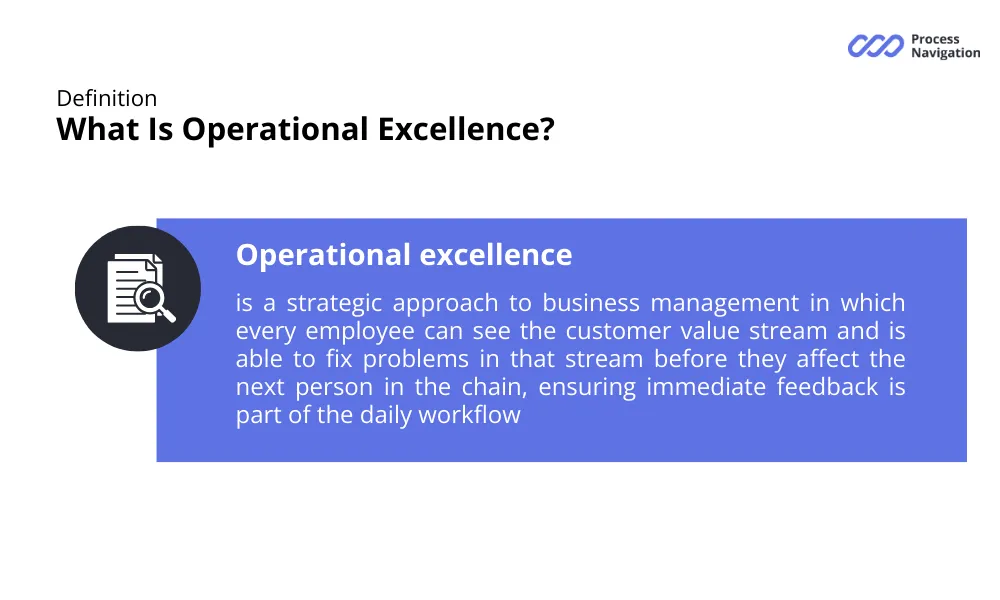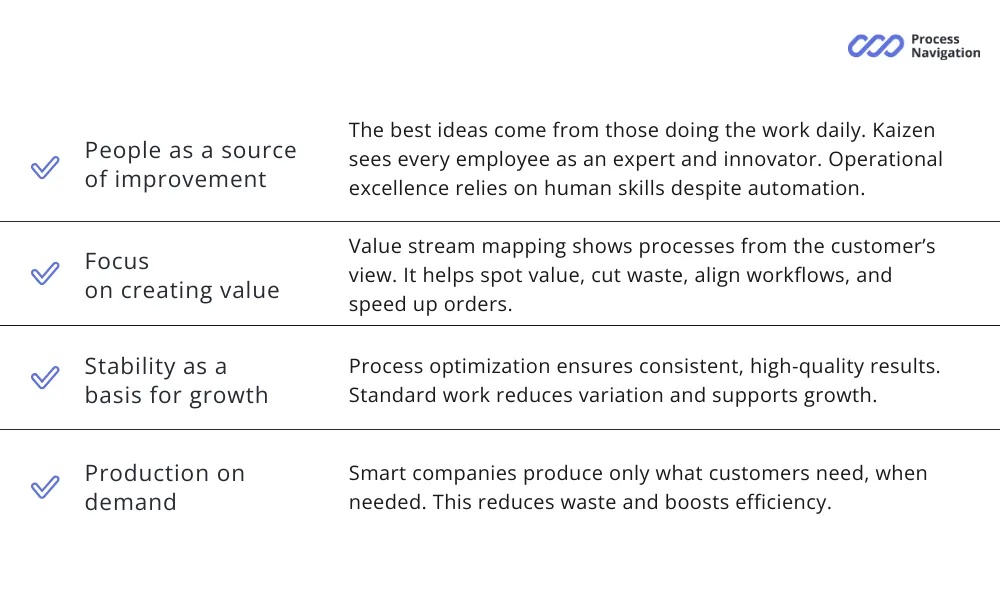Remember the days when a manufacturer’s main concern was simply to produce a plan? Today, that’s not enough. Customers are becoming more demanding, markets are more volatile, and technology is evolving at breakneck speed. In this reality, the companies that survive are those that have made continuous improvement their DNA.
Those that have implemented operational excellence — not as a one-time action, but as a way of life for the entire organization. Operational excellence remains the cornerstone of modern manufacturing transformation, providing a foundation for business leaders to make informed decisions and adapt faster.
What Is the Meaning of Operational Excellence?
Operational excellence is a strategic approach to business management in which every employee can see the customer value stream and is able to fix problems in that stream before they affect the next person in the chain, ensuring immediate feedback is part of the daily workflow.
This is not just a set of tools to improve efficiency. Operational excellence focuses on enhancing business operations through better resource allocation and waste reduction. It is a holistic management system that combines three key elements:
| Element | Description | Result |
| Philosophy | A culture of continuous improvement (Kaizen), where every process is an opportunity for development | Self-sustaining improvements |
| Methodology | Structured approaches (Lean, Six Sigma, TPM) for problem solving | Stable high results |
| Control system | Daily control and development processes at all levels | Sustainable competitive advantage |
Operational excellence in manufacturing is a management philosophy that prioritizes continuous improvement in all areas of business. It’s about creating systems and processes that are efficient, consistent and high quality so you can serve your clients better and stay ahead of the competition.
Operational excellence must be tightly connected to overall business strategy to deliver sustainable results and maximize company productivity.
Operational excellence differs from simply improving performance in that it focuses not only on results, but also on creating sustainable systems and processes that deliver consistently high performance over the long term.
Continuous Improvement as a Part of Operational Excellence

To achieve operational excellence is the foundation which increases production efficiency. It’s about regularly reviewing and improving processes to eliminate inefficiencies, improve quality and increase production productivity. Organizations can use various operational excellence methodologies such as Lean Manufacturing, Six Sigma and Kaizen to achieve this.
Other operational excellence methodologies such as TQM or Agile can also contribute to continuous performance gains.
Here’s how continuous improvement works in practice:
- Identify Opportunities: Look for areas where performance is lagging or processes are outdated.
- Prioritize Changes: Focus on changes that will have the greatest impact on efficiency or customer satisfaction.
- Analyze Data: Use metrics and analytics to understand key problems and potential solutions to improve business processes.
- Validate Results: Implement changes on a small scale, test, refine and then scale up.
Organizations aiming for sustainable growth must implement methodologies that align with their operational goals and customer expectations.
Proven Operational Excellence Methodologies
Here are three of the most widely accepted approaches:
- Lean Manufacturing
Lean manufacturing principles are based on a ruthless fight against losses. There are eight main types of losses in manufacturing:
| Type of loss | Examples | Elimination tools |
| Overproduction | Manufacturing of parts beyond the order | Kanban, pull systems |
| Expectation | Equipment downtime, queues | Line Balancing, TPM |
| Transportation | Unnecessary movement of materials | Optimization of planning, 5S |
| Working longer than necessary | Extra operations in the process | Standardization, poka-yoke |
| Stocks | Excess warehouse stock | Just-in-time, replenishment systems |
| Transportation | Inefficient workplace organization | 5S, Ergonomics of workplaces |
| Defects | Manufacturing defects, rework, complaints | Quality control, Six Sigma |
| Unrealized potential | Unused ideas from employees | Suggestion systems, learning |
The goal of Lean tools is to refine every aspect of the manufacturing process to eliminate inefficiencies and streamline operations.
A core objective of operational excellence is minimizing waste at every stage of production, from raw material usage to final delivery. These methodologies, originating from Japan’s competitive success in manufacturing, demonstrate how systematic approaches lead to business success.
- Six Sigma: Accuracy through Data
Six Sigma methodology uses a statistical approach to minimize variation in processes. The methodology is based on the DMAIC cycle:
- Define: clearly formulate the problem and goals
- Measure: collect baseline data about the process
- Analyze: search for root causes through root cause analysis
- Improve: develop and test solutions
- Control: consolidate results into standards.
- Total Productive Maintenance
TPM turns every operator into a conscious owner of their equipment. The result is a significant increase in Overall Equipment Effectiveness (OEE):
| OEE component | What does it measure | Target value | Typical problems |
| Availability | Operating time without breakdowns | >90% | Unplanned downtime |
| Performance | Operating speed relative to nominal | >95% | Microstops, speed reduction |
| Quality | Proportion of good products | >99% | Defects, rework |
| Common OEE | All three exponents | >85% | Complex losses |
What are the Typical Results of Operational Excellence Implementation?
Companies that have successfully implemented operational excellence in manufacturing achieve impressive results:
| Indicator | Typical improvement | Time to achieve |
| Performance | + 15-30% | 6-12 months |
| Order fulfillment time | – 25-50% | 3-9 months |
| Stock level | – 20-40% | 6-18 months |
| Overall equipment effectiveness | up to 85%+ | 12-24 months |
| Number of defects | – 50-90% | 6-18 months |
| Cost of production | – 10-25% | 12-36 months |
Monitoring key performance indicators allows companies to track progress and adjust their improvement strategies effectively.
In addition to the numbers, companies receive:
Cultural changes
- Increased employee engagement in the improvement process
- Developing problem-solving skills at all levels
- Forming proactive thinking instead of reactive.
High levels of employee involvement are crucial for successfully embedding operational excellence into daily routines. A strong company culture rooted in openness and learning is essential for sustaining operational excellence over the long term.
Strategic advantages
- Increased flexibility and speed of adaptation to market changes
- Creation of barriers to entry for competitors through operational efficiency
- Building a reputation as a reliable supplier.
Key Principles of Operational Excellence

People as Drivers of Improvement
Strategic leadership commitment begins with a simple understanding: the best ideas come from those who do the work every day. Kaizen culture is built on the fact that each employee is an expert in his or her workplace and a potential innovator.While automation plays a growing role, operational excellence still depends heavily on the skills and judgment of human workers to identify improvement opportunities.
Focus on Delivering Value
Through value stream mapping, companies learn to look at their processes through the eyes of the customer. This helps:
- Identify operations that really add value.
- Find hidden losses in processes (waste elimination).
- Synchronize the work of all links in the chain.
- Reduce the overall order fulfillment time.
Process mapping helps visualize workflows and uncover inefficiencies that hinder productivity and quality.
Stability as a Foundation for Growth
Process optimization aims to create predictable results. Standard work routines ensure that each operation is performed in an optimal way, reducing variability and increasing quality.
Production Driven by Demand
Instead of storing finished products “in reserve,” smart companies are switching to a pull system: producing only what customer demand requires, when it is needed.
Stages of Operational Excellence Development
| Stage | Duration | Key tasks | Expected results |
| 1. Assessment and planning | 2-3 months | Process diagnostics, team building | Transformation strategy, selection of pilot zones |
| 2. Pilot projects | 3-6 months | Implementation of 5S, standardization, visual management | First quick wins, trained team |
| 3. Scaling | 6-12 months | Replication of practices, development of management | Improvements of system, performance dashboards |
| 4. Rooting Culture | 12+ months | Integration into corporate processes, development of competencies | Self-sustaining system of improvements |
Control and Measurement System
Daily management system (DMS) creates a rhythm of continuous improvement through structured daily processes:
Morning meetings (15 minutes)
- Review previous day’s metrics
- Identify issues and deviations
- Assign priorities for the day
- Track improvement status
Evening summary (10 minutes)
- Analysis of plan implementation
- Recording problems for solution
- Planning actions for tomorrow
Hoshin Kanri (policy deployment) provides a link between the company’s strategic goals and the daily work of each employee, enabling informed business decisions:
| Level | Planning horizon | Key indicators | Revision frequency |
| Corporation | 3-5 years | ROI, revenue growth, market share | Annually |
| Enterprise | 1 year | Cost, quality, supplies | Monthly |
| Department | Quarter | OEE, performance, safety | Weekly |
| Section | Month | Plan fulfillment, number of improvements | Daily |
Digital Transformation of Operational Excellence
Digital transformation in manufacturing is fundamentally changing approaches to operational excellence. Industry 4.0 integration brings new opportunities:
IoT Sensors and Monitoring
- 24/7 equipment status monitoring
- Predictive analytics to prevent breakdowns
- Automatic data collection for performance KPI dashboard
Real-time Data Analytics
- Instant detection of deviations from normal parameters
- Automatic notifications of problems
- Intelligent decision support
Visual Management at a New Level
Today it is not just boards with graphs. Modern digital panels provide:
| Management level | Information on the panel | Refresh rate |
| Workplace | Current tasks, quality, safety | Real time |
| Section | Performance, OEE, issues | Every hour |
| Department | Plan execution, key indicators | Every day |
| Enterprise | Financial results, strategic goals | Weekly |
Common Mistakes in Achieving Operational Excellence and How to Avoid Them
Common challenges include:
- Lack of management support: initiatives fade, employees lose motivation. How to avoid: personal involvement of top management in projects, inclusion of OPEX in KPI.
- Focus on tools only: temporary improvements without long-term effect. How to avoid: investing in people and culture change.
- Lack of measurements: inability to measure progress and ROI. How to avoid: creating a KPI system with baseline and target values.
- Ignoring resistance: sabotage of initiatives, conflicts within the team. How to avoid: working with motivation, explaining benefits, engaging skeptics.
- Trying to change everything at once: chaos, resource overload. How to avoid: step-by-step approach, focus on pilot projects.
Understanding the principles of operational excellence helps organizations drive operational excellence through systematic approaches that build organizational excellence while maintaining focus on product quality.
FAQ
6S is a methodology for workplace organization and safety (Sort, Set in order, Shine, Standardize, Sustain, Safety). Six Sigma is an approach to improving quality and reducing defects through analysis and statistics.
Small and medium-sized companies often achieve results faster than large corporations due to greater flexibility and less bureaucracy. The key is to choose the right scale and complexity of tools. For example, simple visual boards can be used instead of complex IT systems, and basic problem-solving methods can be used instead of formal Six Sigma programs.
The primary metrics for measuring operational excellence include: Cycle Time: Duration needed to execute a complete workflow from initiation to completion. Productivity Rate: Volume of output or deliverables produced during a specified timeframe. Right-First-Time Rate: Proportion of work or output that achieves quality requirements without rework or corrections.
The main investment is employee time for training and participation in improvement projects (usually 2-4 hours per week). Most OpEx tools do not require large capital expenditures. The typical ROI is 300-500% in the first year due to reduced waste and increased efficiency.
The most important metrics include Overall Equipment Effectiveness (OEE) which measures equipment performance, First Pass Yield showing quality levels, and Lead Time indicating process speed. Companies also track Cost of Poor Quality (COPQ), employee engagement in improvement activities, and the number of implemented kaizen suggestions per employee.
An optimal Opex-to-Revenue Ratio varies by sector, but typically ranges between 65% and 85% for manufacturing companies. A lower ratio indicates more efficient operations, with greater revenue available for capital investments, equipment upgrades, and business expansion.
Implementing operational excellence requires more than just tools — it demands structure, visibility, and standardization across all levels of operations. One effective way to achieve this is by using digital platforms designed to support continuous improvement. ProcessNavigation is a powerful solution that enables manufacturers to digitize their standard operating procedures (SOPs), checklists, and workflows. With real-time task tracking and centralized production data, teams can reduce downtime, and ensure consistency in performance. By integrating ProcessNavigation into daily operations, companies can improve company productivity, elevate product quality, and build a strong culture of continuous improvement. The platform also helps standardize and scale best practices across multiple sites — giving manufacturers a real competitive advantage. Learn more at processnavigation.com.
-
 Maintenance Plan: What Is It And How Does It Work
Maintenance Plan: What Is It And How Does It WorkIn modern manufacturing, equipment downtime costs businesses thousands of dollars an hour. The difference between...
Technology
-
 Competency Management
Competency ManagementModern businesses face a big challenge: how do you ensure every employee has the skills...
Technology
-
 Unlocking the Benefits of Total Quality Management
Unlocking the Benefits of Total Quality ManagementIn today’s competitive world, the quality of products and services is becoming the key to...
Technology
